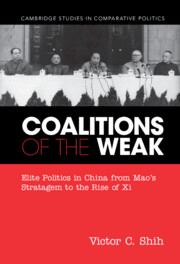Book contents
- Coalitions of the Weak
- Cambridge Studies in Comparative Politics
- Coalitions of the Weak
- Copyright page
- Dedication
- Contents
- Figures
- Tables
- Acknowledgments
- 1 Introduction
- 2 Coalition of the Strong
- 3 “Counterrevolutionary Splittists” in Mao’s Ruling Coalition
- 4 The Scribblers Mafia
- 5 Realizing the Coalition of the Weak
- 6 The Collapse of the Coalition of the Weak and Power Sharing in the 1980s
- 7 Weak Successors
- 8 Conclusion and the Future of the Chinese Communist Party
- References
- Index
5 - Realizing the Coalition of the Weak
Politics in the Late-Mao Period
Published online by Cambridge University Press: 26 May 2022
- Coalitions of the Weak
- Cambridge Studies in Comparative Politics
- Coalitions of the Weak
- Copyright page
- Dedication
- Contents
- Figures
- Tables
- Acknowledgments
- 1 Introduction
- 2 Coalition of the Strong
- 3 “Counterrevolutionary Splittists” in Mao’s Ruling Coalition
- 4 The Scribblers Mafia
- 5 Realizing the Coalition of the Weak
- 6 The Collapse of the Coalition of the Weak and Power Sharing in the 1980s
- 7 Weak Successors
- 8 Conclusion and the Future of the Chinese Communist Party
- References
- Index
Summary
Even at an abstract theoretical level, the power configuration in China after the 1969 9th Party Congress was highly unstable. On the one hand, Mao continued to be an active and powerful chairman of the party. On the other hand, Lin Biao, the anointed successor, had a great deal of control over the military. Without the possibility of other powerful factions in the party to check a potential fight between Mao and Lin, both sides had much temptation to eliminate the other if they believed they had sufficient power to do so (Acemoglu et al. 2008: 162). Fortunately for Mao, he had cultivated two disparate groups to help him govern China in the event of a purge of Lin Biao: the Fourth Front Army (FFA) and the surviving scribblers. Mao’s strategy of cultivating the tainted FFA paid off handsomely. Instead of having to concede to Lin Biao’s reluctance to carry out self-criticism or being forced to rely on Lin’s followers, Mao forced Lin’s hand, knowing that he could credibly threaten Lin with replacing the Lin Biao faction with FFA veterans. After Lin Biao fled, Mao carried out his threat and eradicated close associates of Lin Biao wholesale from the military, replacing them with veterans of the FFA. The Lin Biao incident on September 13, 1971, finally led to the full installation of the coalition of the weak.
Keywords
- Type
- Chapter
- Information
- Coalitions of the Weak , pp. 109 - 134Publisher: Cambridge University PressPrint publication year: 2022



